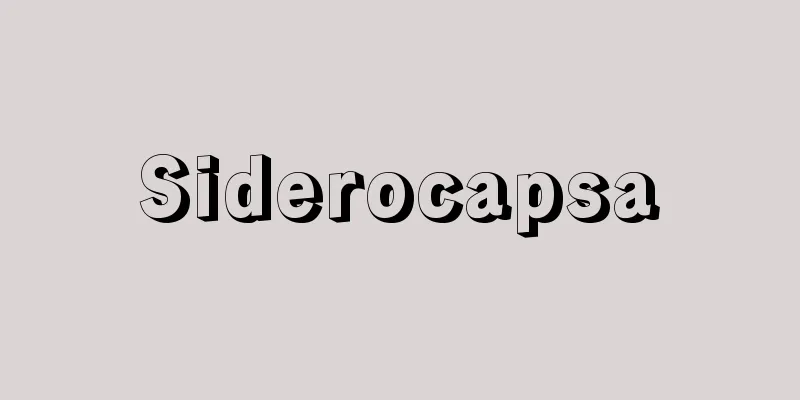Alicyclic compound - Alicyclic compound

|
A general term for compounds in which only carbon atoms are bonded in a ring, excluding aromatic compounds such as benzene. Because their properties are similar to those of chain-type aliphatic compounds, they are called " alicyclic compounds," an abbreviation of "aliphatic cyclic compounds." There are also unsaturated alicyclic compounds with double or triple bonds in the ring. Unsaturated alicyclic compounds have essentially similar properties and reactivity to the corresponding open-chain substituted alkenes and substituted alkynes. Alicyclic compounds with two or more ring structures are also known. They are widely distributed in nature as the basic skeletons of terpenes, steroids, sex hormones, etc. [Toshio Mukai and Masaru Hirota] NomenclatureAlicyclic hydrocarbons in which all carbon atoms are saturated are called cycloalkanes, those with one double bond in the ring are called cycloalkenes, and those with one triple bond in the ring are called cycloalkynes. Cycloalkanes have the structure CnH2n , cycloalkenes CnH2n - 2 , and cycloalkynes CnH2n - 4 . Alicyclic hydrocarbons are generally named after the name of an aliphatic hydrocarbon with the same number of carbon atoms, with the prefix cyclo added, meaning "ring". As shown in , when eight saturated carbon atoms are arranged in a ring, it is named cyclooctane, which is a combination of cyclo (ring) + octane (a C8 chain saturated hydrocarbon). Also, when a hydrocarbon contains multiple bonds, double bonds are expressed with "ene" and triple bonds with "yen", so when one of the CC bonds in cyclooctane becomes a double bond, it becomes cyclooctene. In other words, it is cyclo (ring) + octane ( C8 hydrocarbon) + ene (double bond compound) = cyclooctene (the "n" at the end of the names of saturated hydrocarbons with the same number of carbon atoms, such as octane and pentane, is omitted because it overlaps with the endings of "ene" and "yen" that express bonds). Alicyclic compounds with two or more double bonds in one ring are also known. The prefixes di (2), tri (3), tetra (4), etc. are used before the double bond "ene" or triple bond "yne" to indicate the number of multiple bonds in the ring: cycloalkadienes (two double bonds), cycloalkatrienes (three), cycloalkatetraenes (four), etc. For example, the name of 1,5-cyclooctadiene in is a combination of cyclo(ring) + octane ( C8 hydrocarbon) + di(two) + ene (double bond compound), and means a compound with two double bonds in a ring of eight carbon atoms. The first 1,5- indicates the position of the double bond. When writing the structure of alicyclic hydrocarbons in chemical , they are often written as a (regular) polygon with the same number of angles as the atoms that compose the ring, for convenience, such as an equilateral triangle for the three-membered ring of cyclopropane, and a pentagon with a double line representing a double bond for the five-membered ring of cyclopentene, as shown in the upper part of Figure B (1). Polycyclic compounds with two or more rings are named by adding a numeral such as bi (2), tri (3), or tetra (4) before "cyclo" (IUPAC nomenclature), but this method is complicated, as shown in the lower part of (1), so common names such as (2) are often used. [Toshio Mukai and Masaru Hirota] Classification by ring sizeThe ring compound C n H 2 n is obtained by removing one hydrogen atom from each end of an alkane chain and forming a C-C bond. This is called a cycloalkane, and is known to include compounds ranging from the three-membered cyclopropane to large rings. The properties of alicyclic compounds are similar to those of the parent chain compounds, but differences in stability and reactivity appear depending on the size of the ring. Therefore, it is useful to classify them into small ring compounds (3- and 4-membered rings), normal ring compounds (5- to 7-membered rings), medium ring compounds (8- to 11-membered rings), and large ring compounds (12 or more membered rings) and consider their properties such as reactivity ( ). [Toshio Mukai and Masaru Hirota] Three-dimensional structure: Ring distortion and conformationTo see why reactivity changes depending on the size of the ring, let's consider the three-dimensional structure of cycloalkanes, that is, the shape of the molecule. The normal bond angle of a saturated carbon atom is 109.5°, but for three-, four-, and five-membered ring compounds, if the molecule has a planar structure, the bond angles are 60°, 90°, and 108°. In cyclopropane (three-membered ring) and cyclobutane (four-membered ring), the difference from the normal value of 109.5° is large, so the bond angle strain is large, and the molecule has high energy and becomes unstable. In contrast, the bond angle of the five-membered ring cyclopentane is 108°, which is close to the normal value, and so if we consider only the bond angle, the distortion is small and the molecule is stable. However, in a planar cyclopentane molecule, the hydrogen atoms of adjacent methylene groups -CH 2 - overlap, resulting in steric instability. To avoid the steric repulsion caused by this hydrogen overlap, the cyclopentane molecule does not have a completely planar structure, but rather has a slightly pleated structure. This pleated structure is created by twisting the CC single bond. The various shapes of a molecule that arise from changes in the torsion angle around the bond are called conformations. In cyclopentane, the torsion angle does not remain constant, and the conformation changes fluidly. In the case of cyclohexane with six members, the bond angles between the carbon atoms are close to 109.5°, and the molecule has a highly symmetrical conformation with no distortion. Even in this case, many conformations can be generated by simply twisting the CC bonds without breaking any bonds in the molecule. The most stable conformation among these, and the majority of cyclohexane molecules at room temperature, is the chair conformation. In the chair conformation, all CC bonds are twisted so that the overlap of hydrogen atoms between adjacent methylene groups is minimized. In the well-known boat conformation, the hydrogen atoms at the bow and tail of the boat are close to each other, and the overlap of hydrogen atoms between the four methylene groups is maximized. Therefore, the boat conformation is less stable than the chair conformation and cannot actually exist stably. At room temperature, an equilibrium exists between these various conformations, and they can be converted to each other, but the stable chair conformation is overwhelmingly more prevalent ( ). In medium-sized ring compounds, the bond angle between carbon atoms is close to 109.5°, and the rings deviate from the planar structure to form a three-dimensional structure with almost no angle distortion. However, hydrogen atoms of adjacent methylene groups may overlap, or hydrogen atoms may face inward and overlap, causing repulsion due to van der Waals forces, which may cause instability. In cyclononane (9-membered ring) and cyclodecane (10-membered ring), the conformation in which the hydrogen atoms at the 1st, 5th, 1st, and 6th positions face inward is stable. In these medium-sized ring compounds, transannular reactions between close carbon atoms are a characteristic reaction. In addition, in large ring compounds with 12 or more members, the degree of molecular freedom is large, and the bond angle between carbon atoms (∠CCC) is normal, and the conformation in which there is no repulsion between the hydrogen atoms of the methylene groups can be formed is stable and reactive, similar to that of chain compounds. [Toshio Mukai and Masaru Hirota] SynthesisAlicyclic compounds are generally synthesized by treating a chain of compounds with substituents at both ends that react with each other to form a C-C bond with a suitable reagent to link the two ends of the chain to form a ring. The following reaction is commonly used to synthesize alicyclic compounds: (1) Cycloalkanes are synthesized by reacting α,ω-dibromoalkanes, both ends of which are bromine-substituted, with metals such as zinc, magnesium, and sodium. This reaction produces cycloalkanes with the same number of carbons as the dibromoalkane used as the starting material (intramolecular Wurtz reaction). (2) When calcium or barium salts of α,ω-alkanedicarboxylic acids, both ends of which are substituted with carboxyl groups, are pyrolyzed, a cycloalkanone is produced, which has one fewer carbon atom than the original carboxylic acid. This can then be reduced to a cycloalkane (this is known as the Ruzicka reaction). (3) When an α,ω-alkanedicarboxylate diester with carboxylate ester groups (-COOR) at both ends of the chain is heated with a base such as sodium ethoxide, an alcohol molecule is eliminated from one of the carboxylate ester groups at both ends of the chain to produce an α-ketocycloalkanecarboxylate. Cycloalkanones and cycloalkanes can be derived from this ester (Dieckmann condensation). (4) Cycloalkanes can also be synthesized from α,ω-alkanedicarboxylic acid diesters by acyloin condensation using metallic sodium, for example (acyloin condensation). (5) α,ω-alkanedicarbonitriles substituted at both ends with cyano groups can be cyclized with sodium amide as a base to give α-iminocycloalkanecarbonitriles, from which cycloalkanones and cycloalkanes can be derived (Thorp-Ziegler cyclization). The reactions (3) to (5) are suitable for the synthesis of large cycloalkanes, which are difficult to synthesize using conventional methods and have low yields ( ). Alicyclic compounds are rich in diversity, and include cage-type compounds such as cubane and adamantane, as well as compounds with structures in which multiple cyclohexane or cyclopentane rings are condensed, such as terpenes and steroids. When discussing the physiological activity of natural alicyclic compounds, the issue of optical isomerism cannot be ignored, since only one of the two optical isomers that are mirror images is active. [Toshio Mukai and Masaru Hirota] [References] | | |©Shogakukan "> Example of naming alicyclic compounds (Figure A) ©Shogakukan "> Nomenclature of alicyclic compounds (Figure B) ©Shogakukan "> Chair conformation and boat conformation (Fig. C) ©Shogakukan "> Synthesis of alicyclic compounds (Fig. D) ©Shogakukan "> Ring size and strain of cycloalkanes... Source: Shogakukan Encyclopedia Nipponica About Encyclopedia Nipponica Information | Legend |
|
炭素原子だけが環状に結合している化合物のうち、ベンゼンなどの芳香族化合物を除いたものの総称。その性質が鎖式の脂肪族化合物に似ていることから、「脂肪族環式化合物」を略して「脂環式化合物」とよばれている。 環の中に二重結合や三重結合をもつ不飽和脂環式化合物もある。不飽和脂環式化合物は相当する鎖式の置換アルケンや置換アルキンと本質的に似た性質や反応性を示す。また二つ以上の環構造をもつ脂環式化合物も知られている。天然にはテルペン、ステロイド、性ホルモンなどの基本骨格として広く分布している。 [向井利夫・廣田 穰] 命名法すべての炭素原子が飽和されている脂環式炭化水素をシクロアルカン、環内に二重結合が一つあるものをシクロアルケン、環内に三重結合が一つあるものをシクロアルキンという。シクロアルカンはCnH2n、シクロアルケンはCnH2n-2、シクロアルキンはCnH2n-4の組成をもつ。脂環式炭化水素は、一般に同数の炭素原子をもつ鎖式(脂肪族)炭化水素名を基にして、これに「環」を意味する接頭語シクロ(cyclo)をつけて命名する。 のように、飽和の炭素原子8個が環状に並んでいるものは、シクロ(環)+オクタン(鎖式C8飽和炭化水素)=シクロオクタンと名づけられる。また、炭化水素が多重結合を含む場合、二重結合には「エン」、三重結合には「イン」をつけて表すため、シクロオクタンのC-C結合の1本が二重結合になるとシクロオクテンとなる。すなわち、シクロ(環)+オクタン(C8炭化水素)+エン(二重結合化合物)=シクロオクテンである(オクタンやペンタンなど、同炭素数の飽和炭化水素名の語尾の「ン」は、結合を表す「エン」や「イン」の語尾と重なるので省略する)。 一つの環に二つ以上の二重結合をもつ脂環式化合物も知られている。二重結合が二つある場合はシクロアルカジエン、三つある場合にはシクロアルカトリエン、四つある場合にはシクロアルカテトラエン……のように、接頭語ジ(di)=2、トリ(tri)=3、テトラ(tetra)=4……を、二重結合「エン」や三重結合「イン」の前につけて、環内にある多重結合の数を示す。 たとえば、の1,5-シクロオクタジエンの名前は、シクロ(環)+オクタン(C8炭化水素)+ジ(二つ)+エン(二重結合化合物)をあわせてつくった名前で、8個の炭素原子からなる環の中に二重結合が二つある化合物を意味している。最初の1,5-は二重結合の位置を示している。 脂環式炭化水素の構造を化学式で書くときには、の(1)の上段のように、シクロプロパンの3員環は正三角形、シクロペンテンの5員環は二重結合を表す二重線をもつ五角形などのように、便宜上、環を構成する原子と同数の角をもつ(正)多角形で書き表すことが多い。また、2個以上の環をもつ多環式化合物は、ビbiまたはジ(2)、トリ(3)、テトラ(4)などの数詞を「シクロ」の前につけて命名するが(IUPAC命名法)、この方法はの(1)の下段に示すように複雑なので、しばしばの(2)のような慣用名を用いる。 [向井利夫・廣田 穰] 環の大きさによる分類アルカンの鎖の両端の炭素原子から、それぞれ1個の水素原子を取り去り、C-C結合をつくると環式化合物CnH2nができる。これがシクロアルカンで、3員環のシクロプロパンから大環状のものまで知られている。 脂環式化合物の性質は、母体の鎖式化合物に似ているが、環の大きさによって、安定性や反応性に相違が現れてくる。そこで、小環状化合物(3、4員環)、正常環状化合物(5~7員環)、中環状化合物(8~11員環)および大環状化合物(12員環以上)に分けて反応性などの諸性質を考えると便利である()。 [向井利夫・廣田 穰] 立体構造――環のひずみと立体配座なぜ環の大きさが異なると反応性が変わるのか、シクロアルカン類の立体構造、すなわち分子の形から考察してみよう。飽和炭素原子の正常の結合角は109.5°であるが、3員環、4員環および5員環化合物は分子が平面構造をとるとすれば、その結合角は60°、90°、108°となる。シクロプロパン(3員環)やシクロブタン(4員環)では、正常値の109.5°からの差が大きいので、結合角のひずみ(ストレインstrain)が大きくなって、分子は高いエネルギーをもち不安定化する。 これと対照的に、5員環のシクロペンタンでは結合角は108°で正常値に近いので結合角だけを考えると、ひずみは小さく安定である。しかし平面構造のシクロペンタン分子では隣どうしのメチレン基-CH2-の水素が重なり合い立体的不安定化をもたらす。この水素の重なり合いによる立体反発を避けるために、シクロペンタン分子は完全な平面構造ではなくすこしひだのある構造をとる。このひだのある構造はC-C単結合をねじることによってできる。結合の周りのねじれ角の変化によって生ずる分子のさまざまな形を立体配座(コンホメーション)という。シクロペンタンではねじれ角が一定の値をとらず立体配座は流動的に変化する。 6員環のシクロヘキサンになると各炭素間の結合角は109.5°に近くなり、まったくひずみのない対称性の高い立体構造をとる。この場合にも、分子内のどの結合も切断することなく、単にC-C結合をねじることによって、多数の立体配座が生ずる。このうちもっとも安定で、常温のシクロヘキサン分子の大部分がとっているのが椅子(いす)形配座である。椅子形では隣どうしのメチレン基の水素の重なりが最小になるようにすべてのC-C結合がねじれ形配座をとっている。よく知られている舟形では舟首と舟尾の水素が近づくほか、四つのメチレン基の水素の重なりが最大になる。したがって、舟形配座は椅子形配座よりも不安定で、実際には安定に存在することができない。常温においてこれら種々の配座の間には平衡が存在し、相互に変換しうるが、安定な椅子形が圧倒的に多い割合で存在する()。 中環状化合物においても、炭素の結合角は109.5°に近くなり、環は平面構造からずれて、角度ひずみのほとんどない立体構造をとるが、隣どうしのメチレン基の水素間の重なりが生じたり、水素原子が環の内側に向かい重なり合ってファン・デル・ワールス力による反発を生じたりして、不安定化の原因となる。シクロノナン(9員環)やシクロデカン(10員環)などでは、1、5位、1、6位の水素が環の内側を向いた配座が安定となる。これら中環状化合物では、接近した炭素間での渡環反応が特徴的な反応として現れてくる。また、12員環以上の大環状化合物になると、分子の自由度が大きくなり、炭素間の結合角(∠CCC)が正常値をとり、かつメチレン基の水素間の反発も存在しない配座をとり得るので、鎖式化合物と同じような安定性と反応性を示す。 [向井利夫・廣田 穰] 合成法脂環式化合物は、一般に両端にお互いに反応してC-C結合を生成するような置換基をもつ鎖式化合物を適当な試薬と処理して、鎖の両端を結び付けて環をつくる方法により合成する。次の反応が脂環式化合物の合成によく使われる。 (1)鎖の両端を臭素置換されたα,ω-ジブロモアルカンを亜鉛、マグネシウム、ナトリウムなどの金属と反応させてシクロアルカンを合成する。この反応では原料のジブロモアルカンと同数の炭素をもつシクロアルカンができる(分子内ウルツ反応)。 (2)鎖の両端をカルボキシ基(カルボキシル基)で置換したα,ω-アルカンジカルボン酸のカルシウム塩やバリウム塩を熱分解すると、もとのカルボン酸に比べると炭素数が一つ少ないシクロアルカノンができる。これを還元するとシクロアルカンになる(ルジーチカ反応、ルチッカ反応ともいう)。 (3)鎖の両端をカルボン酸エステル基(-COOR)で置換されたα,ω-アルカンジカルボン酸ジエステルをナトリウムエトキシドなどの塩基と加熱すると、鎖の両端のカルボン酸エステル基の一方からアルコール1分子が脱離してα-ケトシクロアルカンカルボン酸エステルができる。このエステルからシクロアルカノンやシクロアルカンを誘導できる(ディークマン縮合)。 (4)α,ω-アルカンジカルボン酸ジエステルから金属ナトリウムなどを用いるアシロイン縮合によっても、シクロアルカンが合成できる(アシロイン縮合)。 (5)鎖の両端をシアノ基で置換されたα,ω-アルカンジカルボニトリルを、ナトリウムアミドを塩基として用いて環化させるとα-イミノシクロアルカンカルボニトリルができる。この化合物からシクロアルカノンやシクロアルカンを誘導できる(ソープ‐チーグラー環化)。 (3)から(5)の反応は、通常の方法では収率が低く合成しにくい大環状シクロアルカンの合成に適している()。 脂環式化合物は多様性に富み、キュバン、アダマンタンなどの籠(かご)型化合物や、テルペンやステロイドのようにシクロヘキサン環やシクロペンタン環が多数縮合した構造をもつ化合物も知られている。天然脂環式化合物の生理活性を論ずるには、鏡像関係にある二つの光学異性体のうち一方のみが活性なので、光学異性の問題を無視できない。 [向井利夫・廣田 穰] [参照項目] | | |©Shogakukan"> 脂環式化合物の命名の実例〔図A〕 ©Shogakukan"> 脂環式化合物の命名法〔図B〕 ©Shogakukan"> 椅子形配座と舟形配座〔図C〕 ©Shogakukan"> 脂環式化合物の合成〔図D〕 ©Shogakukan"> シクロアルカン類の環の大きさとひずみの… 出典 小学館 日本大百科全書(ニッポニカ)日本大百科全書(ニッポニカ)について 情報 | 凡例 |
Recommend
New Usuyuki Monogatari - Shin Usuyuki Monogatari
Joruri Gidayubushi. Historical piece. Three acts....
Pioneer Project
An American planetary and interplanetary space ex...
Hanazono [Village] - Hanazono
A village in Ito District, northeastern Wakayama P...
Anion
…Furthermore, when we examine the components of t...
Ankaran - Ankaran
...They also share many cultural, social and econ...
Polo - polo (English spelling)
Four players compete with each other to get the b...
Guru Govind Singh
1666‐1708 The 10th guru of Sikhism in India. He be...
Opium alkaloid atropine
...Side effects vary widely from person to person...
Gavialis gangeticus (English spelling)
...A species of the Gharialinae subfamily of the ...
Egyptian Music
A great deal of information about ancient Egyptia...
Bukka
…It was succeeded by four different royal lines: ...
Tokorozawa [city] - Tokorozawa
Sayama City is located in the southern part of Sai...
Iburi Izo - Iburi Izo
Year of death: June 9, 1907 Year of birth: Tempo 4...
Sadataka Ise
Year of death: September 11, 1562 (October 8, 1562...
Tarakan [island] - Tarakan
A small island off the northeast coast of Indonesi...









